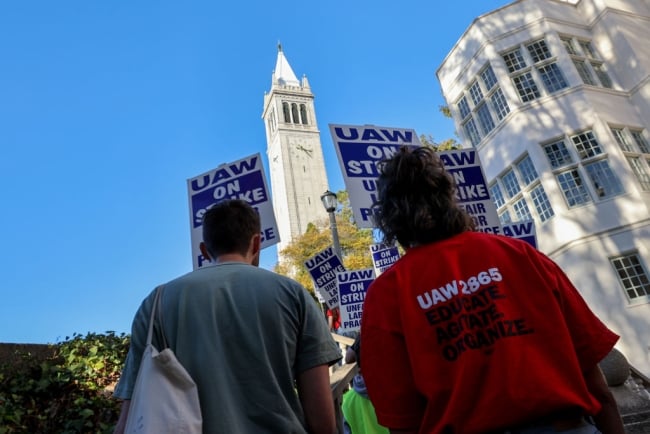You have /5 articles left.
Sign up for a free account or log in.

Striking academic workers at the University of California, Berkeley, in November.
Anadolu Agency/Contributor/Getty Images
Labor unions are in the news a lot these days. And it’s fair to say that conditions in higher education are ripe for a level of labor activism not seen in recent decades.
Labor organizing and collective bargaining efforts at companies like Starbucks, Amazon and Apple—companies once thought to be immune from union pressures—are seeing some success. Although union membership remains at historic lows as a percentage of the country’s total workforce, the number of employees joining unions grew by nearly 275,000 in 2022. And the number of petitions filed for new labor elections grew by more than 50 percent from the previous year. Unions were winning more than three out of every four elections in the first half of last year, mirroring a greater–than–70 percent general approval of labor unions in the country at large.
Labor strife is in the news too, particularly in higher education. And perhaps that’s not surprising, because depending on whom you talk to, higher education institutions are either “great employers” or utterly “failing their workers.”
In January, a nearly weeklong faculty strike at the University of Illinois at Chicago upended operations and led to canceled classes for thousands of students before the faculty union and administrators reached a tentative four-year deal (the union has since ratified the contract).
The country’s largest labor walkout of the last year began in mid-November at the University of California. There, 48,000 postdoctoral scholars, teaching assistants and graduate student researchers walked off their jobs for nearly six weeks across the UC system’s 10 campuses over disputes involving working conditions, compensation, protections against harassment and alleged unfair labor practices. Smaller strikes and labor disputes continued to ripple outward at UC campuses into 2023.
And just this week, Temple University graduate student workers approved a new labor agreement, ending a six-week strike.
All told, about 60 percent of the nearly 225,000 employees who engaged in work stoppages last year were educators, researchers and other academic professionals.
And post-pandemic concerns in higher education about inflation, working conditions and job protections—not to mention a more employee- and union-friendly National Labor Relations Board (where labor disputes affecting private college and university employees would be resolved) than existed during the previous presidential administration—continue to fuel union efforts to organize more and more graduate students, contingent faculty and other higher education workers. Graduate students voted to unionize at Massachusetts Institute of Technology and Clark and Fordham Universities in early 2022, and graduate students scored lopsided union representation election wins more recently at Boston and Yale Universities.
Other universities around the country—Indiana University, the University of Texas, Florida State University, the University of Chicago and Johns Hopkins University among them—are seeing various types of collective action by their graduate students, including protest rallies and “grade-ins.”
Duke University and the University of Pennsylvania, perhaps trying to get ahead of any union activism on their own campuses, are increasing graduate stipends and other benefits. Similar increases were announced for graduate students at the State University of New York at Buffalo, Rice University and the University of North Carolina at Chapel Hill, too.
Colleges and universities increasingly rely on graduate students and contingent—part-time or adjunct—faculty to cover teaching workloads at less cost and greater flexibility for the institutions, but typically with less job security and significantly less compensation and benefits than full-time faculty members receive. S&P and Fitch, two of the nation’s major credit ratings agencies, each noted inflationary pressure on compensation and labor shortages or pressures as significant challenges and risks for many institutions in 2023.
Despite all this, higher education leaders don’t seem to be overreacting.
In an annual policy survey of the nation’s top state-level higher education officers, neither the kinds of labor issues identified above—nor solving them—garnered specific mention among the top 24 priorities reported for 2023 (though the effect of inflation on the costs of goods or services was mentioned). The survey conducted by the State Higher Education Executive Officers Association revealed instead that higher education leaders view economic and workforce development, K-12 teacher preparation, equity issues, state funding and affordability, enrollment declines, and the public perception and value proposition of higher education as being among their top priorities.
Higher education leaders will likely find common ground with labor leaders and newly organized graduate students and other academic workers if their discussions center on how to best serve learner needs, grow economically valuable research output and enhance the value proposition in higher education as a whole. But when there are diverging opinions on campus about whether an institution is either a “great employer” or utterly “failing [its] workers,” the seeds of labor activism and unrest will find fertile ground to grow.




